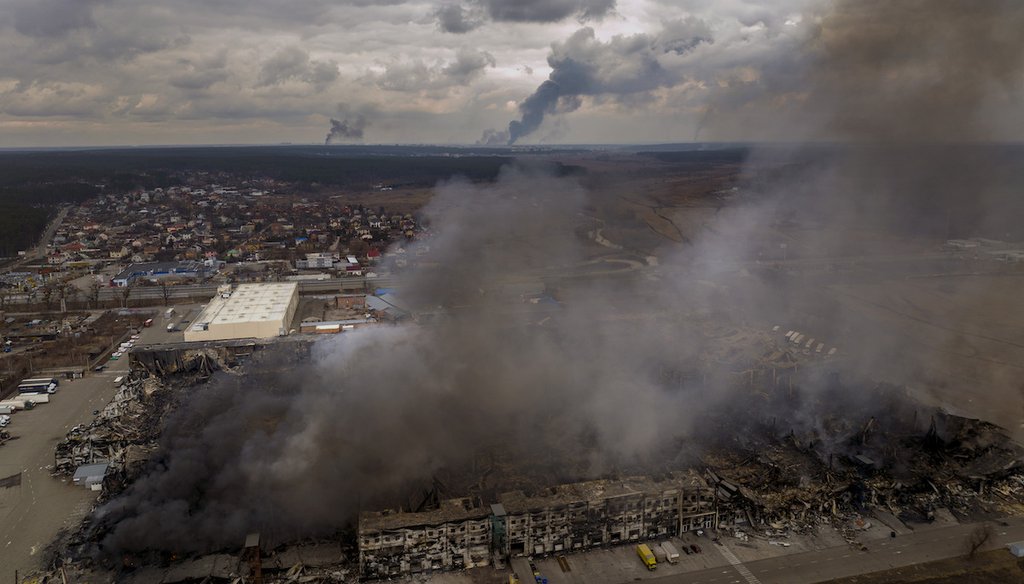Stand up for the facts!
Our only agenda is to publish the truth so you can be an informed participant in democracy.
We need your help.
I would like to contribute

Russian attacks on Ukrainian cities raise concern over the fate of labs that work with dangerous pathogens. (AP)
If Your Time is short
-
Ukraine has about a dozen labs that research pathogens that can kill humans and animals.
-
The U.S. helps support those labs, plus smaller ones around the country that diagnose the presence of dangerous microbes.
-
These labs have a long history of working on public and agricultural health concerns, and no evidence shows they have moved outside of that.
Russia, China and right-wing American media have been spreading false stories about U.S.-backed bioweapon labs in Ukraine.
"We confirm facts, unearthed as part of the special military operations, which testify to an emergency attempt to erase evidence of military biological programs," Russian Foreign Ministry spokeswoman Maria Zakharova said March 9.
China’s Foreign Ministry tweeted March 8, "The US has 336 labs in 30 countries under its control, including 26 in Ukraine alone. It should give a full account of its biological military activities at home and abroad and subject itself to multilateral verification."
Fox News’ Tucker Carlson joined in March 9, saying, "We never imagined Ukraine would have biological weapons."
But as Carlson described it, his eyes were opened when Victoria Nuland, U.S. undersecretary of state, had this exchange with Sen. Marco Rubio, R-Fla.
"Does Ukraine have chemical or biological weapons?" Rubio asked.
"Ukraine has biological research facilities, which, in fact, we are now quite concerned Russian forces may be seeking to gain control of," Nuland said. "So, we are working with the Ukrainians on how they can prevent any of those research materials from falling into the hands of Russian forces should they approach."
For Carlson, this was proof positive that Ukraine has "secret labs," and that what Russia has said is, "in fact, totally and completely true."
Let us be clear: There is no evidence of Ukrainian bioweapon labs. The Russian talking point is not, as Carlson said, "totally and completely true."
There are labs in Ukraine, backed by the United States, the European Union, Canada and the World Health Organization. These labs work with a number of pathogens, including the ones that cause anthrax, plague and hemorrhagic fever in humans. They study viruses that affect birds and pigs.
That does not make them bioweapon facilities. Virtually every nation has labs to deal with the threat of microbes that drive disease, and some of those microbes are especially deadly.
The U.S. Defense Department said March 11 that when the Russian attack began, "the Ukrainian Ministry of Health responsibly ordered the safe and secure disposal of samples. These actions limit the danger of an accidental release of pathogens should Russia’s military attack laboratories."
Contrary to what Carlson said, these are not secret labs. The Global Partnership Working Group, a multilateral body, lists the domestic institutes and agencies that run these labs in its annual reports. (The U.S. supports labs in more than 20 countries.) For at least two years, the U.S. Embassy in Ukraine had a page on its website that described the U.S. role in these facilities. That page remains active, and it has details on the 13 major facilities where research takes place. There are other, smaller labs that only identify pathogens.
The Defense Department said in a fact sheet that since 2005, it has spent $200 million in Ukraine supporting 46 Ukrainian laboratories, health facilities and diagnostic sites. It works with Ukrainian health and agriculture ministries and agencies. Those organizations have limited contact with Ukraine’s military, providing mobile diagnostic labs in case of a public health emergency.
"These are all public health and veterinary labs," said Gregory Koblentz, director of the Biodefense Graduate Program at George Mason University. "None of them have been involved in biological warfare."
A 2012 report by the U.S. National Academy of Sciences included a section on the labs in Ukraine that dealt with potentially lethal microbes. Three Ukrainian labs were equipped to work with some of the more dangerous pathogens such as anthrax, and, with U.S. assistance, had been upgraded to the level needed to work with diseases transmitted by breathing.
In addition to labs that worked on identifying the presence of pathogens, Ukraine also had a storage center where it kept samples of both indigenous and exotic pathogens.
Carlson used the terms biolab and bioweapon lab interchangeably. There is always the question of whether a lab that studies pathogens could be used to turn one into a weapon. Much of the equipment is similar. But an actual weapons program takes more.
"The reality is that a real biological weapon program has additional requirements, such as formulating an agent to be able to be mass-produced and stable enough to be stored and disseminated," Koblentz said.
Beyond that, there are issues of production and delivery systems.
"These are not activities that most public health labs are capable of doing," he said. "They can diagnose a disease but not conduct the more advanced work to convert a pathogen into a biological weapon."
Like all but a handful of countries, Ukraine has signed the 1972 Biological Weapons Convention, which bans the development, production and possession of biological weapons. The convention lacks an independent verification process, though Ukraine has voluntarily submitted compliance reports..
The Defense Department program that works with labs in Ukraine started after the fall of the Soviet Union in 1991. The initial focus was on Russian biological and chemical weapons facilities. The Soviet military program included some labs in Ukraine, and the primary goal of the U.S. was to repurpose them for peaceful uses.
Since 2005, through the Biological Threat Reduction Program, the U.S. and Ukraine have had an agreement to upgrade the country’s biological research laboratories.
"All of the labs have long since been converted for biosurveillance and testing," said RAND researcher Daniel Gerstein, who served in the Homeland Security Department in the Obama administration. "One of the diseases that everybody in Europe is now concerned about is African swine fever, so that would be an example of a pathogen that they might study."
The conversion of the labs involved a lot of hands-on work by American specialists, he said.
"We found the best way to tell what the scientists were doing, and how well they were performing, and what the risk was for a possible accident or misuse, was through cooperative biological research," he said.
That engagement is ongoing, and in itself acts as a way to verify what takes place at the labs. Ukraine has been open to specialists from the U.S. and Europe, said Hayley Severance, deputy vice president of the Nuclear Threat Initiative. She served as an adviser to the Defense Department during both the Obama and Trump administrations.
"Ukraine’s willingness to partner with countries like the U.S. and to grant them access to their laboratories demonstrates that they have nothing to hide," Severance said.
A spokesman with the Russian Defense Ministry explained on March 10 how papers "received from various sources" on the migration of ducks and bats proved the labs’ dangerous activities. The presentation failed to answer how studying how a virus could cross borders must be a sign of bioweapons research, and not an effort to protect public or animal health.
At Russia’s request, the U.N. Security Council planned to meet March 11 to discuss Russia’s claims.
Our Sources
National Academies of Sciences, Engineering, Medicine, High-containment laboratories in Ukraine: Local Resources and Regulations, 2012
National Academies of Sciences, Engineering, Medicine, The Biological Threat Reduction Program of the Department of Defense, 2007
Global Partnership Working Group, Annual project report, 2018
U.S. Defense Department, Fact sheet on the Department of Defense's Cooperative Threat Reduction Program - Biological Threat Reduction Program Activities in Ukraine, March 11, 2022
Reuters, WHO says it advised Ukraine to destroy pathogens in health labs to prevent disease spread, March 10, 2022
Congressional Research Service, The Evolution of Cooperative Threat Reduction: Issues for Congress, Nov. 23, 2015
U.S. Embassy in Ukraine, Biological Threat Reduction Program, accessed March 10, 2022
U.S. State Department, Agreement between the United States of America and Ministry of Health of Ukraine Concerning Cooperation in the Area of Prevention of Proliferation of Technology, Pathogens and Expertise that could be Used in the Development of Biological Weapons, August 29, 2005
Factcheck.org, Social Media Posts Misrepresent U.S.-Ukraine Threat Reduction Program, March 2, 2022
Globalbiolabs.org, "Tracking BSL-4 Labs Around the World," March 10, 2022
Centers for Disease Control and Prevention, "Recognizing the Biosafety Levels"
AA, Russia says documents suggest 'components of bioweapons were being developed in Ukraine', March 9, 2022
EuroNews, Russia demands U.S. explain biological programme in Ukraine, March 10, 2022
Reuters, U.S. dismisses Russian claims of biowarfare labs in Ukraine, March 9, 2022
Chinese Foreign Ministry, tweet, March 8, 2022
Fox News, Tucker Carlson: Someone needs to explain why there are dangerous biological weapons in Ukraine, March 9, 2022
Al Jazeera, US denies Russian claims of biowarfare labs in Ukraine, March 10, 2022
Russian Defense Ministry, Briefing on the results of analysis of documents, March 10, 2022
Interview, Daniel Gerstein, senior policy advisor at Rand Corporation and former Homeland Security official, March 10, 2022
Email exchange, Gregory Koblentz, director, Biodefense Graduate Program, George Mason University, March 10, 2022
Email exchange, Hayley Severance, deputy vice president, Global Biological Policy and Programs, Nuclear Threat Initiative, March 10, 2022

























